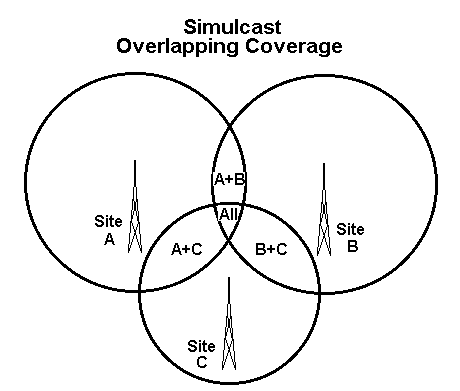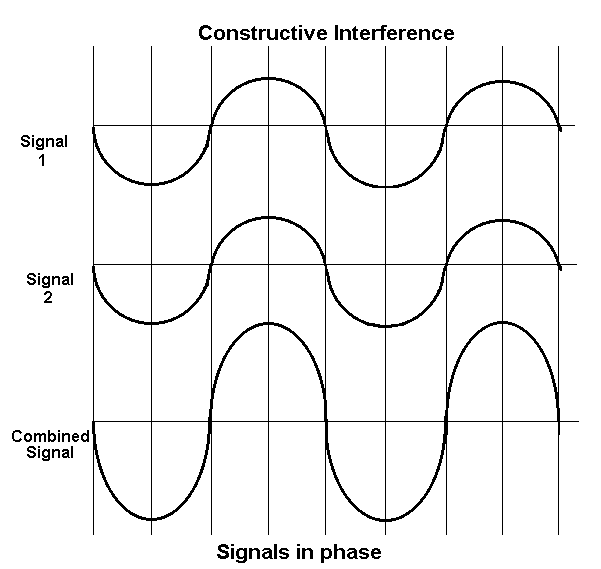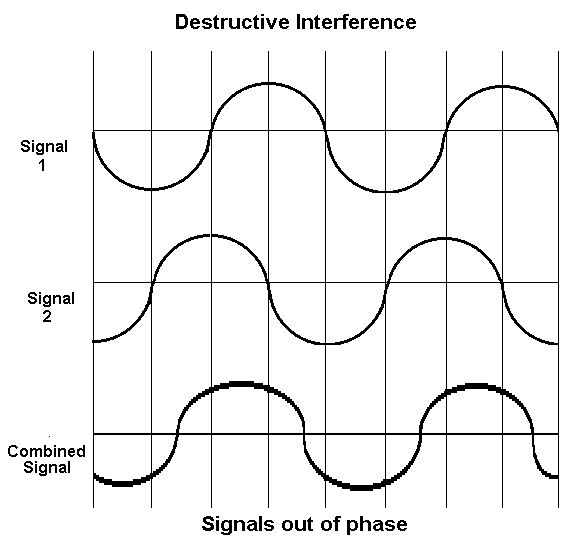Large trunked radio systems almost always require the use of several transmitter sites in order to provide complete service. Typically, the coverage area is larger than one transmitter site can handle, so a number of sites in different locations are used. Terrain may also dictate multiple transmitter sites. For instance, a mountain ridge dividing a county might require a transmitter site on each side.
Having more than one transmitter site gives the system a number of advantages. Mobile and portable radios will have a wider coverage area. Reception will be better due to stronger signals from closer or better located transmitters. The stronger signals also penetrate buildings more effectively, allowing users to have coverage inside as well as out in the open.
There are some disadvantages to having multiple transmitter sites. Besides the additional cost of installation and maintenance, each transmission must be coordinated among overlapping transmitter sites. Since the number of radio frequencies available is limited, a transmitter site may have to share the same frequency with other sites. Two transmitters located near each other and operating simultaneously on the same radio frequency will interfere with each other.
Transmitter Steering
One of the simpler methods of preventing interference is to allow only one transmitter site to be active at a time. The trick, of course, is to pick the transmitter site that will provide the best signal to the mobile user.
The simplest method is for the dispatcher to manually select the correct site, but this prone to error and would add another task to an already very busy person. For a small system that is fairly quiet, however, this might be an acceptable solution.
Some systems are equipped with devices that provide this transmitter steering function automatically. These devices operate on the theory that the best transmitter site to reach a particular mobile or portable radio is the site that can receive that radio the best.
When a mobile user calls the dispatcher, voting receivers at various locations make note of the received signal strength. A comparator uses the votes from each receiver to determine the best transmitter to reach that user. On the assumption that the dispatcher will immediately answer the mobile user, the system selects the site that had the best signal for the next transmission.
Transmitter steering is a relatively inexpensive way to have the benefits of multiple transmitter sites, but there are limitations. The comparator could make the wrong decision, leaving the mobile user unable to hear the response. Calls from mobile users in different areas coming one right after another could also cause problems. Regardless of how good the steering is, any individual mobile user will not be able to hear transmissions occurring through far away transmitter sites.
Simulcast
Rather than having to choose a single transmitter for a transmission, it is possible to have more than one transmitter send a signal at the same time. Simulcast, short for simultaneous broadcasting, is the process of sending the same message on the same radio frequency through more than one transmitter.
Simulcast provides the users with a very simple mode of operation, that is, all transmissions are sent through all the transmitter sites. In this way all the mobile users are able to hear every message from the dispatcher regardless of their location.
Each transmitter site has a specific geographic area of coverage. Overlap areas are those areas where signals from more than one transmitter site are strong enough to provide good reception.

Interference
In locations where multiple simulcast signals are arriving at a receiver, one of two things will happen. If the signal from one transmitter is significantly stronger than the others, the stronger signal will "capture" the receiver and overpower the weaker ones. You may have experienced this with FM radio stations as you're driving between cities. One minute you're listening to a station from the city behind you and suddenly your radio picks up the station from the city ahead of you. This is known as the capture effect, and it holds true for trunked radios as well as FM broadcast stations.
Complications arise when the receiver is in an overlap area and picks up two equally strong signals. Those signals will add together inside the receiver to produce a signal that is the combination of the two transmitted signals.
You can think of the two radio signals as waves, with peaks and troughs as they travel from the transmitter to the receiver. If the content of the two signals is the same and the signals arrive at the receiver at exactly the same time, the peaks and troughs will match each other and the two signals will reinforce each other. In this condition the signals are described as in-phase and result in constructive interference. Most receivers perform very well with this positive type of interference.

However, if the content of the two signals is the same but the signals do not arrive at the receiver at the exact same moment, the peaks and troughs won't match up. This condition is known as out of phase and results in destructive interference. The resulting combined signal will be distorted to some degree, depending on how far apart in time the two signals arrived at the receiver. If the signals are far enough out of phase the distortion will be so severe that the receiver will be unable to extract the content of the signal.

Destructive interference is useful in the audio world. Signals that are exactly 180 degrees out of phase will have peaks and troughs that exactly cancel each other out. The result is no signal, which is the idea behind active noise-canceling headphones. Outside noise is sampled, turned 180 degrees in phase, and when played at the right time exactly cancels the noise.
Alignment
In order to handle the interference problem in overlap areas, simulcast transmitters must be correctly synchronized with each other to transmit the signal at the proper instant. The idea here is to make sure the two signals arrive in the center of the overlap area at the exact same time, or as closely as possible. Since it takes a radio signal about 5.3 microseconds to travel one mile, if the center of an overlap area is 31 miles from transmitter A and 22 miles from transmitter B, it will take a signal 164 microseconds from transmitter A and 117 microseconds from transmitter B to reach the center. If transmitter B waits 47 microseconds before transmitting, the signals will arrive at the center at the same time. This time delay is known as alignment and is implemented using special audio or digital delay equipment.
So how do you make sure all of the simulcast transmitter sites are synchronized? In the past some systems were clocked to the National Information Standards and Technology (NIST, formerly the National Bureau of Standards) radio station for time known by the call letters WWV in Ft. Collins, Colorado. Other systems used atomic clocks based on the radioactive decay of cesium or rubidium.
These days it is easier and cheaper to use satellites from the Navstar Global Positioning System, more commonly known as GPS. The United States Department of Defense operates a constellation of 24 active satellites in orbit that provide position location information to both military and civilian users. These satellites also provide precise timekeeping signals with an extremely high level of accuracy. By equipping each transmitter site with a GPS time receiver, all transmissions can be coordinated precisely in time to arrive with a minimum of destructive interference.
There is a slight risk for public safety agencies to rely on GPS, however. The Department of Defense has always retained the option of turning off civilian access to GPS during times of war or crisis in order to deprive the enemy of a free positioning service. Tests conducted over the past few years have also shown that it is relatively easy to jam GPS. Should GPS become unavailable and a simulcast system had no other source of timekeeping data, mobile radios could become unusable in overlap areas.
Simulcast systems also make use of voting receivers and a comparator. Since the signal from a mobile user could be received at more than one location, voting receivers select the best signal and retransmit it throughout the system. In this way the best signal is always repeated regardless of the mobile user's location.
Have scanner, will travel
If you're like me, when you travel you take a trunking scanner along to follow the action in large cities and airports. I don't always have time to sit down and preprogram the scanner before I leave, so I often have print-outs of frequency lists and talkgroups stuffed in my luggage with the idea that I'll be able to do it sometime during the trip.
I'd like to hear your methods for organizing and maintaining the many pages of information you keep about different trunked radio systems. Do you use a spiral-bound notebook with hand-written sections for each system, or do you use a Palm Pilot synchronized with a database on your home computer? Do you use a commercial or freeware computer program to organize your listings? Do you have a special interconnect cable that allows you to load frequencies directly from your PC into your scanner? Send me e-mail or write to me in care of Monitoring Times with your tips and tricks.
Chicago's Midway Airport
A brief update on Midway airport in Chicago, which served 13 million passengers in 1999. The $761 million Midway Airport Terminal Development program, the largest public works program in Illinois, is scheduled for completion next year. Part of that program is an upgraded radio system.
The fire department will use 154 MHz. Police and emergency services will share frequencies in the 460 MHz to 468 MHz band, and the Chicago Department of Aviation will have a trunked radio system on frequencies between 476 MHz and 480 MHz.
I'd love to hear from scanner listeners in Chicagoland who have specific frequencies and talkgroups when these new systems come on-line.
That's all for this month. I'm continuing to add more trunking and general radio information to my website at www.signalharbor.com, and as always I welcome electronic mail at dan@signalharbor.com. Until next month, happy monitoring!